More than 5 years ago, Occupy Wall Street (OWS) sparked a public dialogue about the current economic situation in the United States, through protests in Zuccotti Park, New York City. OWS not only curated the discussion about the control money has over the government, but also the growth of social inequality throughout the nation. "We are the 99%," a slogan made popular by OWS, represented the trend of an accumulation of the nation's wealth in the hands of only 1% of the population.

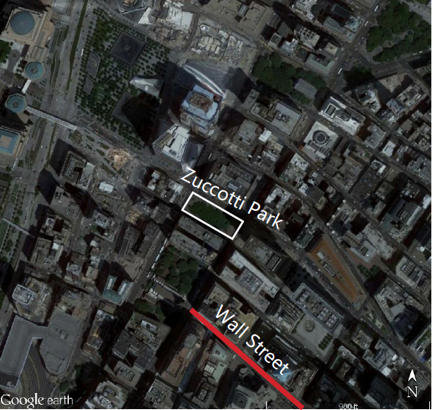
Understanding the Space
Zuccotti Park is a public space that falls under the designation of a privately-owned public space (POPS). Introduced in the 1961 Zoning Resolution, private developers were allowed to build higher than zoning allowed if they opened and maintained a POPS. However not every POPS is created alike. Jerold Kayden (2000), alongside Advocates for Privately Owned Public Spaces, documented every POPS and discovered many did not suit the public. Bad POPS ranged from barren arcades around buildings to small plazas that were unusable due to fencing. A gem among POPS, Zuccotti Park, takes up an entire Manhattan block, which provides much needed green space amidst the skyscrapers of the Financial District. This was seen as the perfect location for OWS due to its proximity to Wall Street, as well as the size and centrality of Zuccotti Park.
In addition, POPS are typically not restricted to the regular opening hours of a public park, which closes at dusk. Because of this OWS created quite a disturbance to many of the surrounding residents and businesses, from small vendors to mega-chains. But Occupiers relied on them for many basic amenities, especially restrooms creating long lines in many restaurants and fast food chains (Buckley, 2011; Ransom & Debaise, 2011). Why is this important? What does it add to the piece?


Zuccotti Park may have been chosen due to its proximity to Wall Street and the Stock Exchange, the very institutions OWS was protesting against. However, through an ArcGIS analysis of the space and demographics of the neighborhood, the demographics of the protesters are very similar to the those residing in the Financial District revealing motives that may not have been declared.
The Demographics of Occupy Wall Street
There is a general understanding that those who live in the Financial District bring home a relatively high income compared to the rest of the city, but by mapping it out in relation to Zuccotti Park and the rest of Lower Manhattan, we can begin to understand just who Occupy affected outside of the financial world. These maps will be compared with the City University of New York's (CUNY) research on the demographics of OWS protesters and supporters conducted during the May 1, 2012 rally and march. A key takeaway of the CUNY study is that a third of the protesters lived in households with annual incomes of $100,000 or more and more than two-thirds held professional jobs (Moynihan, 2013).
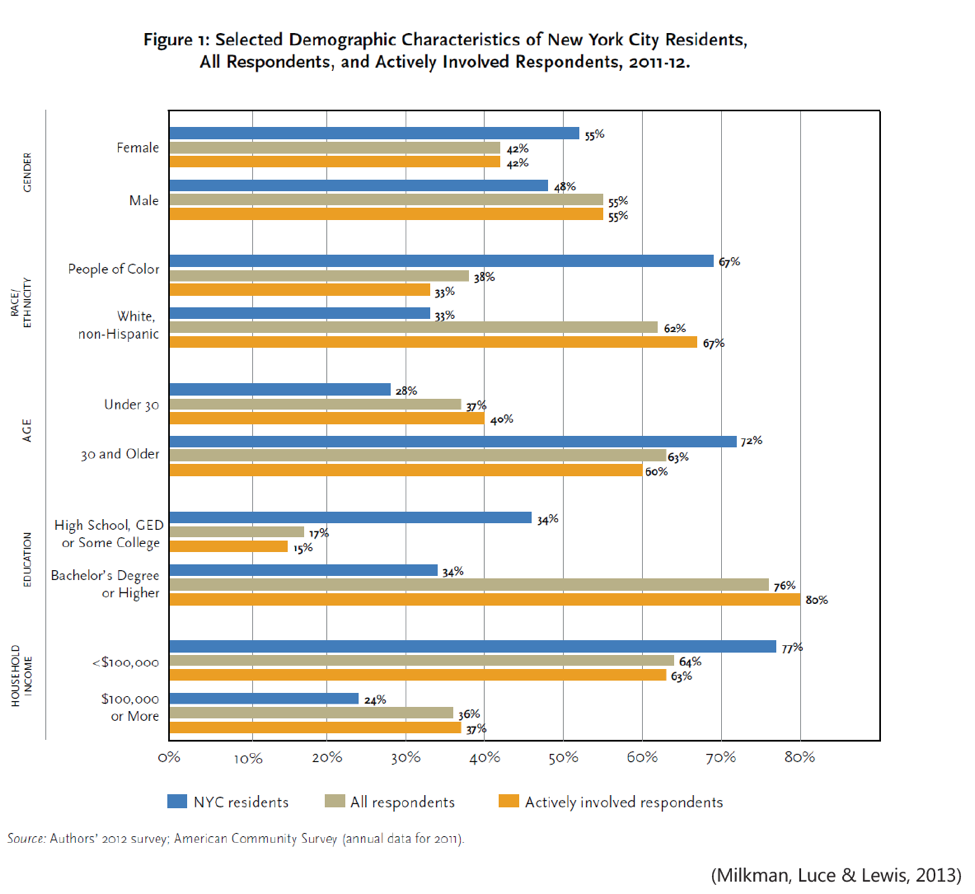
Median Income: The median household income of those living within the Financial District is above $100,000, but directly to the east of the Financial District is some of the lowest median household incomes in the entire city. OWS did spark discussions on minimum wage and cost of living, but the main premise that spread around the world in 2011 was the power big banks have over not only our economic situation and quality of living, but also our political situation. But with the knowledge that some of these protesters lived in households earning more than $100,000, they were protesting within a neighborhood that experience a similar quality of living they potentially have now or grew up with.
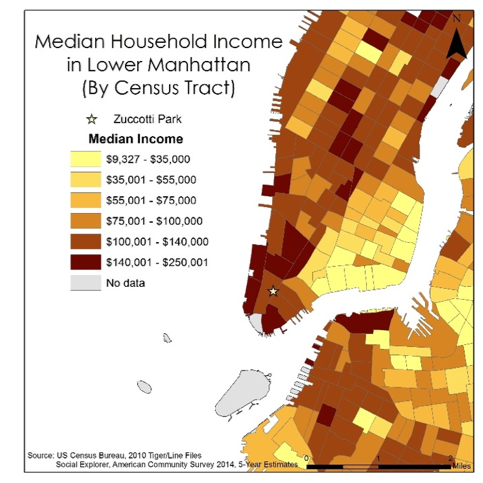
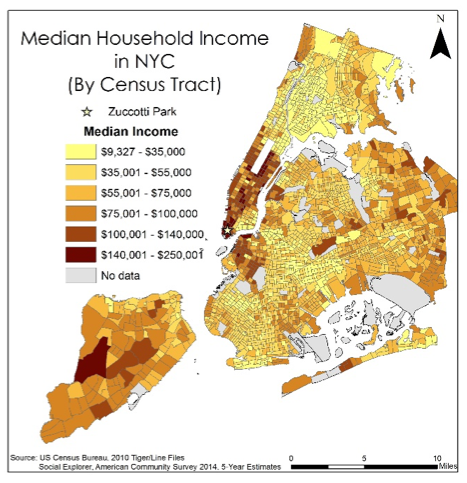
College Education: 80% of the participants of OWS hold a bachelor degree; a stark difference from the 34% of NYC's population that hold a Bachelor's Degree or higher (Milkman, Luce & Lewis, 2013). Occupy movements especially spread throughout college campuses, with encampments set up by students on their quads. At least 83% of the residents of the Financial District have a degree. Relating this to the previous map, those with a college degree tend to have higher household incomes, who may be even part of the financial sector that OWS is protesting on.
By mapping census tracts with college education, we begin to see that higher education may be a requirement for high paying jobs. But with the demographics of the Occupiers, this trend of attaining higher education, which typically is not free, may not be paying off in the jobs some were promised.
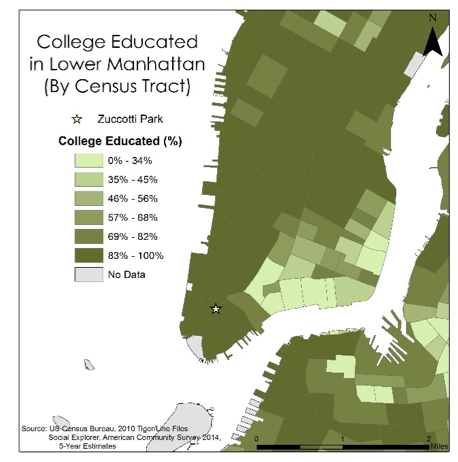
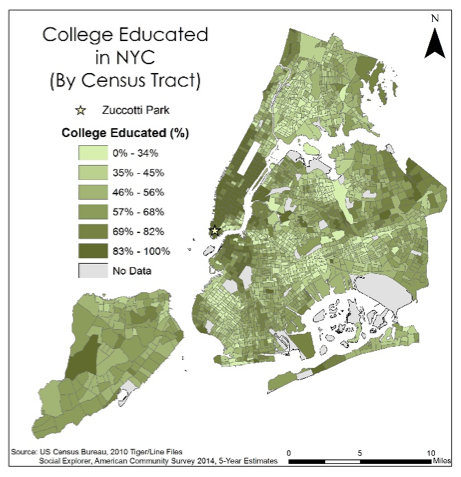
Unemployment Rate: The unemployment rate of those over the age of sixteen is between 5-10% within the Financial District (Social Explorer), with NYC's unemployment rate at 9.5% in 2010 and 7.2% in 2014 (U.S. Bureau of Labor Statistics). When examining the entirety of NYC, census tracts in Manhattan have relatively low unemployment rates than parts of Brooklyn, Queens, and the Bronx. Milkman, Luce & Lewis (2013) found that many OWS protesters and supporters hold a professional job, but are frustrated with the volatile job market and the lack of stability in their careers (Milkman, Luce & Lewis, 2013). There were also a significant number of Occupiers who were laid off in 2011 or in previous years. Whether employed or not, many believed in what OWS was calling for. However, in many of the interviews published, interviewees did not give their name out, in fear of repercussions from their employers (Schwartz, 2011).


The characteristics of the residents and workers of the Financial District matched those who were occupying Zuccotti Park, with the exception of the unemployment statistic. The fact that 2/3 of the protesters hold professional jobs and 1/3 come from families making over $100,000 (Milkman, Luce & Lewis, 2013) signifies that those who have possibly benefited from this financial system throughout their childhood and now in their careers see the worrying amount of control large multi-national banks hold. With the instability of the job market and the growing accumulation of wealth among the 1%, those experiencing this new job market is find it broken and difficult to enter. With private college tuition averaging $40,614 per year, including room and board (National Center for Educational Statistics), recent graduates who expected stable jobs going into college are finding a difficult job market to enter.
The selection of Zuccotti Park as a privately owned public space also helps fuel the narration of OWS. These were spaces that developers built in order to build higher, in essence sell more. Although POPS have added 80 acres of public space to New York City, roughly 10% of Central Park, developers have been able to build an extra 16 million square feet, roughly 367 acres, which they sell (APOPS). Kayden (2000) found that many POPS are inhospitable to the general public by using features such as fences, spikes to limit seating, and visual barriers hiding it from the public street. Some POPS are just too barren or even too small to use. Here is something that is supposed to be given to the general public, but when all's said and done, it is the developers that benefit.
When examining the demographics of the Financial District and the spatial components of Zuccotti Park, Occupy Wall Street occupied a site that was created through the thinking and processes it is raising awareness about: the control money has over our lives and the increasing gap within social inequality. Yet among the residents of the Financial District, a majority were not part of the 1% the protest focused on. But with many similarities between the Occupiers and the residents, this was a message residents potentially needed to hear about the forces that have allowed them to live in the Financial District.
Tags: New York State , InequalityAdvocates for Privately Owned Public Space, The Municipal Art Society of New York, & Kayden, J.S. (2015). History. Retrieved from http://apops.mas.org/about/ history/
Buckley, C. (2011, Oct. 7). For some, Wall Street is Main Street. The New York Times. Retrieved from http://www.nytimes.com/2011/10/08/nyregion/occupy-wall-street-begins-to-chafe-its-neighbors.html
Bureau of Labor Statistics. Occupational Employment Statistics. Retrieved from http://www.bls.gov/oes/current/oes_nat.htm#00-0000
Flegenheimer, M. (2011, Dec. 16). Occupy group faults church, a onetime ally. The New York Times. Retrieved from http://www.nytimes.com/2011/12/17/nyregion/church-that-aided-wall-st-protesters-is-now-their-target.html
Firger, J. (2012, Jan. 12). 'Occupy' churches. The Wall Street Journal. Retrieved from http://www.wsj.com/articles/SB10001424052970204124204577155090035636750
Johnson, R. (2011, Oct. 26). Where do Occupy Wall Street protesters go to the bathroom? Business Insider. Retrieved from http://www.businessinsider.com/where-do-occupy-wall-street-protesters-go-to-the-bathroom-2011-10
Kayden, J. S. (2000). Privately owned public space : the New York City experience. New York: John Wiley.
Milkman, R., Luce, S., & Lewis, P. (2013). Changing the subject: a bottom-up account of Occupy Wall Street in New York City. New York:Russell Sage Foundation.
Moynihan, C. (2013, Jan. 28). In 'Occupy,' well-educated professional far outnumbered jobless, study finds. The New York Times. Retrieved from http://cityroom.blogs.nytimes.com/2013/01/28/ in-occupy-well-educated-professionals-far-outnumbered-jobless-study-finds
National Center for Educational Statistics. Tuition costs of colleges and universities. Retrieved from http://nces.ed.gov/fastfacts/display.asp?id=76
NYS Department of Labor. Local Area Unemployment Statistics Program. Retrieved from https://www.labor.ny.gov/stats/laus.asp
Ransom, D. & Debaise, C. (2011, Oct. 4). Wall Street protest hurts the 'little guys' nearby. Entrepreneur. Retrieved from https://www.entrepreneur.com/article/220475
Rushkoff, D. (2011. Oct. 5). Think Occupy Wall St. is a phase? you don't get it. CNN. Retrieved from http://www.cnn.com/2011/10/05/opinion/rushkoff-occupy-wall-street/
Saget, B., & Tse, A. (2011, Oct. 5). How Occupy Wall Street turned Zuccotti Park into a protest camp. The New York Times. Retrieved from http://nytimes.com/ interactive/2011/10/05/nyregion/how-occupy-wall-street-turned-zuccotti-park-into-a-protest-camp.html
Schwartz, Mattathias. (2011, Nov. 18). Map: how Occupy Wall Street chose Zuccotti Park. The New Yorker. Retrieved from http://www.newyorker.com/news/news-desk/map-how-occupy-wall-street-chose-zuccotti-park
The Economist. (2012, Jan. 21). Who exactly are the 1%? The Economist Newspaper. Retrieved from http://www.economist.com/node/21543178




